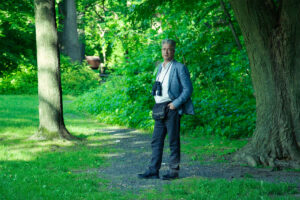
Steven Peck – Green Roofs for Healthy Cities
Steven Peck is dedicated to creating greener, healthier & resilient cities with nature & urban agriculture.
USA
Mood of Living October 10, 2015
Polish-American architect, Daniel Libeskind, is one of today’s most influential and renowned architects, looks to draw attention to architecture’s impact on society with his unique approach to design.
Architecture and its impact on society often goes unnoticed, even though it is the groundwork for every city, town and household. Daniel Libeskind seeks to change this mentality. He has designed over 70 buildings in multiple locations, from Milan to Singapore. His most well-known buildings include the Jewish Museum in Berlin and the Freedom Tower in New York. Libeskind’s extraordinary character is visible in his designs, where sharp edges and clean lines punctuate a city’s skyline.
Libeskind’s parents were survivors of the Holocaust; such adversities have influenced and inspired him and his trademark designs. The Jewish Museum in Berlin, Libeskind’s first ever building, speaks to the complicated history of the relationship between Jews and Germany. History, culture, people, and surroundings influence the way Libeskind shapes his buildings and the way they interact with the city. Today, Libeskind is working on projects all around the world. Few architects can channel their vision and make it concrete, even fewer can go global and make an international impact with their designs. Libeskind has accomplished all of this and more.
Mood of Living: How did your journey from Poland to Israel to New York influence your life?
Daniel Libeskind: I’ve been an immigrant for all of my life since I was 11 years old. I came to America when I was 14. I’ve actually been nomadic in a sense because we’ve moved 18 times across the world with my wife and kids. Often times we would get asked, “Are you with the military?” I say no. They ask, “Are you with a diplomatic service?” No. We just move. We didn’t have any resources, we didn’t have any money, we didn’t have any jobs. That was kind of my intent – go where you want to be, do something, get rid of your past in that sort of way. I had lifetime positions. I was probably the only person who gave up a lifetime position as Artist-in-Residence at the Cranbrook Academy of Art. I had the villa of Charles Eames. I had a garden and gardeners. Everyone who gets this position is there for life; they get the job and retire when they are 75 years old. After 6 years, I said I’ve got to leave.
MoL: Why?
D.L: Because I can’t be in paradise so early on. There’s no struggle, you’ve already achieved nirvana and you’re already doing what you want to do. I’ve always believed that you have to be in a situation where creativity really means something to you. It’s not a job, it’s not a comfort. And I have to say, almost everything that I’ve done since has had a risk to it. Especially moving with the family — I have three kids. When we went to Berlin, we didn’t plan to live in Berlin. I, in fact, avoided Germany. My parents were Holocaust survivors and Germany was never a country I wanted to live in. We just stopped there briefly because I had received the Getty Fellowship, which you don’t apply for, you are selected. It’s a prize, you’re given incredible conditions by the Getty, and you get to do whatever you want to do. You’re supported financially, you even get a villa on the beach. We stopped on our way to Italy in Berlin to pick up this small certificate and prize, which kind of is a staircase to nowhere because nobody intends to build buildings from this competition. As we were walking out of this building, and it was July—the kids were in shorts—I turned to wife, Nina, and said I saw two roads. One that I’ve been traveling on, which is a road of academic successes, a great and privileged life. And then the other road, Berlin. The road to something else that I’ve never done before—because I’ve never built a building before. Not even a small one. I’ve never even planned a building.
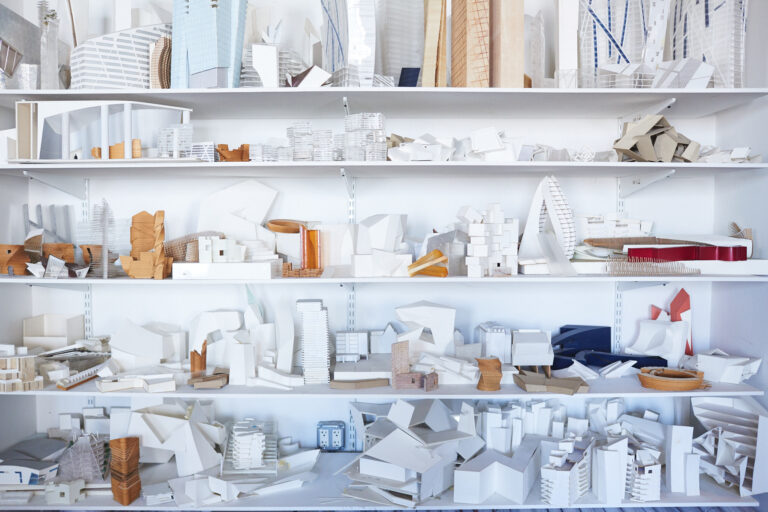
Libeskind’s shelves are filled with architectural models.
MoL: What were you doing prior to this?
D.L: I was in academia. I was a professor. I drew, I wrote things. I had a chair at Yale, I was a professor at Harvard, you know, some privileged positions. But I never built. I never even designed a building. I turned to Nina in Berlin and said, as these roads crossed, let’s stay in Berlin. But on one condition. She said, what’s the condition? I said, that you become my partner. And she said to me, “I’ve never in my life been in an architect’s office!” I said the same applies to me. And I’ve rarely in my life been in an architect’s office. I’ve tried it here and there, but it wasn’t for me, I didn’t really like it. So we walked and checked into a cheap hotel in Berlin with our three kids. My daughter was just an infant at that time. The guy asked, “Why are you here?” — he spoke English. And I said, “To build the Jewish Museum.” And I will never forget, he burst out laughing because there were some headlines in the newspapers, and he said you must be joking. You’re here to do that? And I said yes. Little did I know that you had to have some naiveté. That’s part of it. You have to preserve your naiveté. Don’t be too sophisticated, too clever. I didn’t know what we were getting ourselves into. Not so different from the Ground Zero experience either. Which is similar because you win a competition and you know it’s hoopla but what are you really getting into?
MoL: How do you tackle the challenge of creating an important building and monument?
D.L: My favorite writer, from the Medieval times, wrote a book called The Cloud of Unknowing. And he says something very intelligent. He said if you want to do something, enter the cloud of the unknowing. Not the cloud of the known, but enter this cloud and then you’ll make your way through this… This opacity for which there is no road, there is no fear.
MoL: How did you have the courage to follow your passion? Were you not afraid of not making enough money to pay the everyday bills?
D.L: It’s scary because when we moved to Italy for no reason at all, I quit my job and we took the kids. We had nothing. No electricity, we had no furniture, the kids slept on the floor on some sheets, we had candles.
MoL: How old were your kids at the time?
D.L: One was 6, one was 7, and one was 8.
MoL: What nationality do they feel they are?
D.L: They are global. I mean, that’s what they told me. That’s the one thing that they’ll appreciate, what they’ve learned, by being back and forth across countries. As kids, they said we learned one thing: that it’s good to take risks. And they’ve taken risks in their lives, all of them. One of them works with me; he runs our Milan studio lab. Noam is an astrophysicist, black holes etc. And Rachel is an artist. She’s much younger than her brothers, she’s here in New York. Yeah, it’s more about life than some sort of profession. And architecture is easy. You don’t need a lot. You don’t need computers, you don’t need all that stuff. You need ideas, you need poetry. The things that you practice.

A handful of Libeskind’s fully-realized architectural projects.
MoL: It’s daunting for so many people starting out in their professional lives. The route we are told is to go college, get your masters degree, learn technological and professional skills. It seems to be the route we’ve been told by society that we need to take.
D.L: That’s exactly the opposite of what I’ve found out. Never have a route, never have a plan, never try to. You know, all these business advisors always tell you to have a goal. Have a goal and then you have to get to the goal. My idea was the opposite. Have no goal. Have a path from which you are not pulled from the left or the right. Stay to your path and you get somewhere. You get to an unpredictable—it’s an adventure.
MoL: Tell us about the adventure.
D.L: It’s a spiritual adventure as well. Because if you follow a route, it’s prefabricated. It’s already there and everything along that route has already been done for you. Whereas if you put yourself into this kind of risk, it’s also very hard because when you don’t have money to buy food—and we’ve been in those situations—you know you have to scramble just to survive.
MoL: From my experience, working in the corporate world, it is challenging to be a creative person. The system supports the bottom line, rather than creating an atmosphere that enables the creative spirit to create without fear. I believe by following ones passion, we are able to achieve our personal best.
D.L: Exactly. You need the passion and the intensity and the not caring about some material things that some people think are the most important things in their lives. I always say this. There is a great Jewish thinker, I think it is Rabbi Nachman, who said “Always do what you want to do. Because the worst that could happen if you don’t succeed is that you become poor. And the worst thing that could happen to you if you become poor is that you could starve. And the worst thing that could happen to you if you starve is that you die. But it doesn’t matter because everyone dies anyways. So do what you want to do.” That’s a beautiful piece of wisdom. Just do what you want to do.
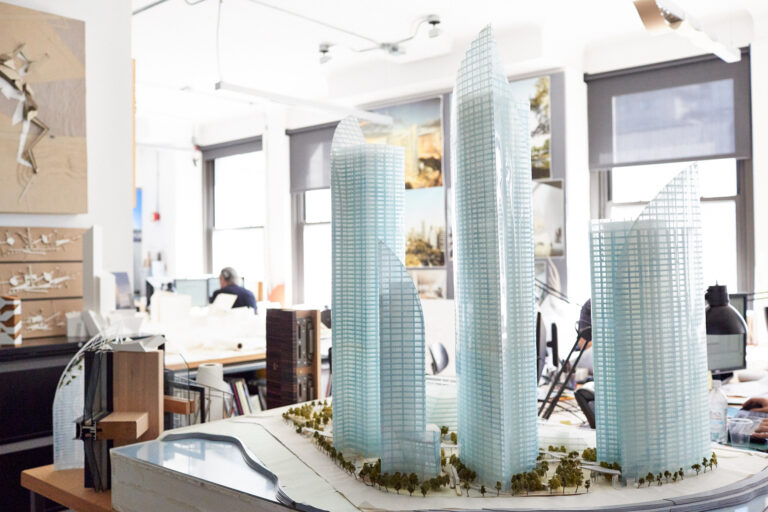
A model of one of Libeskind’s buildings.
MoL: I’ve always thought of myself as a spiritual person. I believe there’s a relationship between creativity and spirituality.
D.L: That’s true. You have to have the freedom to conquer things and you have to have a certain faith in what you’re doing and the authenticity of it. You have to develop this yourself and, of course, you have to learn from the tradition, from the masters. But in the end, you have to take responsibility in any creative act. And you also have to risk failure.
I have to tell you a very funny story. When I came to Berlin, there was a new Senator of Building that came to power. He came to power and his first act, like all governments, was to scrap all the projects of the previous government, like Steven Holl’s American Library and other very famous projects with well-known architects. Next, he calls me and says, “come to the senator building”. And Nina, who’s much wiser than me, said to me, well he’s just calling you to tell you goodbye. But I said, I won the competition. Nina said, that means nothing. He’s just calling you. Indeed, I went to the senate offices. There are maybe 30 bureaucrats in this large office. I see my model, but I also see 25 other models around. It’s clear. We are waiting for the senator. The senator is very powerful in Berlin, more powerful than Berlin itself. He decides the fate of the city. He comes in, very late, everybody’s shaking and nervous. He’s a power figure. And he comes straight to me, doesn’t shake my hand, points his finger to my chest and says, “What buildings have you done in the past that qualify you to build this project?” Now, I haven’t built a single building before. He repeats it even more aggressively: “What big buildings did you do in your past, big buildings, that qualify you to do this project?” So I thought for a second and said, “you know, Senator, if you go from the past, Berlin isn’t going to have any future.” He stopped for a minute and he looked at my model and said, “OK, how do I get into this building?” And I said, for you, Senator, there’s no door. Because there’s no door in this building. You have to go to the Baroque building and go underground to reach the building because German history is not apparent, it lies in the underground of this city. His face slowly changed. It was like a 5-second conversation and he said, Oh my god, you should be the architect of this building. Mind you, he had just come to scrap it, he said it was a ridiculous building. So sometimes you also have to be lucky. You have to have the muses, the gods, the whatever with you to be able to go through situations which seem impossible.
MoL: What part do sustainability and your awareness of your natural surroundings play in your process and thinking?
D.L: Huge. Huge. Because you cannot build a building without really delving deeply into both visible and invisible site. Which is not that apparent to the topography of the site. Of course, you have to master it, you have to understand it, but there are so many things beyond what you can access easily by a computer or a book or an archive. You have to get in touch with the place itself which is unique. For that, you have to have a connection. How that connection is formed, is very special. You cannot will it into existence. You can’t say, “aha I have the connection.” Something has to happen to you, it’s an event.
MoL: And by that happening, you create an experience that you know people will feel good about both inside and out?
D.L: Yes, and that is a connection. Then a world opens to you. Otherwise, most of the buildings built are built very well technically but they don’t have the culture to me. Very few do. Only the great buildings have a soul, something fascinating about them that wherever they have been built, they communicate with you. You understand something beyond just the height.
MoL: Do you think all of the places that you’ve been have influenced your aesthetic?
D.L: Oh, definitely. I’ll tell you how. Every place I’ve been to—Sao Paolo, Paris, Milan, Rome, Singapore, China, Philippines, Berlin, Africa—everywhere I go, no matter where it is, people think that’s the center of the world. You go to Kenya, people think that’s the center of the world. You go to Kuala Lumpur, that’s the center of the world. You go to New York. And suddenly I thought, it can’t be. These are mutually exclusive. Each one claims to be the center of the world. So I’m thinking now, “the center lies elsewhere”. And then you have to bring your experience and, of course, nature and the reality that architecture is also political. It’s the city, it’s the citizens. You’re not doing it for yourself. I often envy artists, writers, because they can work by themselves. They don’t need anybody. They can be at their desks. But architecture is political because it’s in the city it has to do with citizens. I remember someone said to me, I can write any book I want. And I can always find a small publisher, an obscure publisher, and they’ll publish it. But you, Mr. Libeskind, have to get a legal permit from the authorities to do even a small building. I just finished a house in Connecticut. I had to get a legal document to do it. It’s not like getting published. The difference in architecture is that it’s really a very complex art because it’s an art of the city. And it needs the solidarity, the effort, the sense of collaborative space that any building represents because it’s not for you. It’s for others.
MoL: Who’s the most influential figure in your life?
D.L: I tell you, my mother. She was an anarchist. My parents both came from very religious families. They’re both Holocaust survivors. My mother was in camps. She was in the gulags of the Soviet Union, she was hounded. But she never lost a sense of resistance. Resistance. She was somebody who understood freedom in the face of death. It’s so funny to hail your mother as a great influence, but I admired her. When I came home from school, she never asked me what grades I got. Just because somebody says you’re doing well, doesn’t mean you do; that’s just an illusion. Don’t believe success, don’t believe what you’re told. Be tested. Question what you’re doing. She had a very radical sense of self-criticism. She was an Emma Goldman follower. Emma Goldman was the first real feminist, the first woman to stand up and talk about women’s rights and voting. Call her an anarchist, a socialist, whatever, but she was the first factory woman to say “I’m not accepting this”. From the political movement, we still have a long way to go for women equality. My mother was kind of like that. And I was lucky, my parents were survivors of a different kind. I know many survivors who were sad. But my parents had a different sense of the future, of hope, of something positive, maybe because they had kids. And of course, I was lucky to have good teachers and mentors: Peter Eisenman was my teacher, Richard Meier, Aldo Rossi was a friend of mine. I knew many artists and many musicians, so I’ve been very fortunate.
MoL: What advice would you give to young people who have aspirations of becoming an architect?
D.L: I can’t claim the wisdom to give the advice to all the people, but I can say, relying on my own experience: you don’t have to go on the highway. Everybody’s going on the highway. You can take a path which has been untrodden. It’s much slower and might seem not as profitable, but it’s your own path. And I never believed in the big highways. I apprenticed myself with famous architects, and I did try for two days here and two days there and said this really isn’t for me. I don’t really like it. So I say to you, you have to have your own way, you have to take a risk. You have to believe in what you are doing. And then take it somewhere in a way that is threatened by failure. As Beckett said, if you don’t fail you’ll never succeed.I once asked Lloyd Blankfein, the head of Goldman Sachs, “Mr. Goldman, how do you make so much money?” He said, “It’s very easy to explain — you have to lose a lot of money.” Fail again, fail again, fail again, until you do something. Sure, you have to struggle, you have to work very hard, you have to have the discipline, you have to think about something more than yourself. If you just think of yourself, you’re doomed to fail. If you think of others, the people who nobody is thinking about, then you do something. That’s my advice. It’s not really an advice, it’s just my experience.
MoL: I often find who people who lead a creative life have a creative home. Do you cook?
D.L:I can only cook one thing. I can cook an egg, and I can never get it the same way. My wife is a great cook. No, I’m not the cook.
MoL: Where do you go in this fascinating and busy life you have, traveling all over the world, for peace of mind? Where do you find that moment to take a deep breath?
D.L: It’s not a place. I know architects and artists who have to go away, they go somewhere beautiful like a forest or something. I’ve never had that need. It’s kind of instant. Something happens to you somewhere, unexpectedly. It could be at the airport, walking on the street, at a meeting. You are struck by something creative, and it gives you the impetus to have a new sense of life. And it’s kind of like taking a new fresh breath. I am lucky because I love my wife, I love my kids. I’m lucky to live in New York, and I also live in Italy, and I meet interesting people. I’m inspired by people that I meet and by things that I see. It’s just a privileged life, what can I say.
Photography courtesy by Joshua Pestka

Steven Peck is dedicated to creating greener, healthier & resilient cities with nature & urban agriculture.
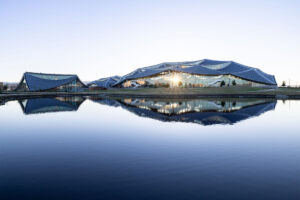
Leading sustainable architect working on scalable innovations to deliver on Google’s 2030 Carbon aspirations and the hybrid future workplace.
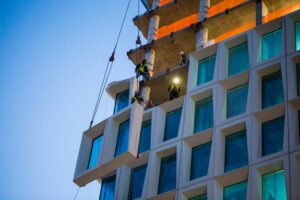
Arno Adkins is Partner at COOKFOX, an architectural studio dedicated to integrated, environmentally responsive design.